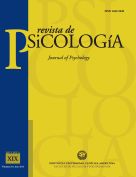Profesores Unidos Para Ayudar – Intervención para promover la literacía de la salud mental en profesores de educación secundaria: Resultados preliminares
Palabras clave:
mental health promotion, mental health literacy, teachers, young people, impact of the interventionResumen
Varios jóvenes experimentan problemas de salud mental significativos que interfieren con su desarrollo, además con frecuencia no tienen los conocimientos necesarios para reconocer los síntomas (Trudgen & Lawn, 2011).
Por lo tanto, los profesores representan un papel fundamental en la detección precoz de problemas de salud mental en sus estudiantes y referenciamiento de servicios de intervención temprana (Graham, Phelps, Maddison & Fitzgerald, 2011; McGorry, Purcell, Hickie, & Jorm, 2007; VicHealth, 2008). Frecuentemente son los primeros en detectar las conductas desadaptativas que afectan el aprendizaje y el funcionamiento general de los jóvenes (Meldrum, Venn & Kutcher, 2009; Trudgen et al., 2011; Whitley, Smith & Vaillancourt, 2012).
El proyecto “Profesores Unidos Para Ayudar” tiene como objetivo promover la literacía de la salud mental en profesores de educación secundaria. La intervención consiste en 2 sesiones, 150 minutos cada una, con una semana de intervalo. Las sesiones siguen una metodología interactiva, utilizando dinámicas de grupo y música y debates en grupo.
El impacto de la intervención se lleva a cabo mediante un análisis pre y pos-test con el “Questionnaire UPA Makes the Difference: Perceptions of mental health problems – teachers’ form”.
Sesenta profesores de educación secundaria han participado en este estudio. El pos-test mostró un incremento significativo en la percepción positiva de los profesores en respecto a problemas de salud mental (menos estigmatizantes), como también un incremento significativo en la percepción de conocimientos sobre problemas de salud mental. Los resultados sugieren que incrementar la literacía de la salud mental es un complemento esencial de las intervenciones escolares, permitiendo así su detección precoz en los jóvenes.
Descargas
Citas
Burns, J. & Rapee, R. (2006). Adolescent mental health literacy. Young people’s knowledge of depression and help seeking. Journal of Adolescence, 29, 225–239. doi:10.1016/j.adolescence. 2005.05.004
Campos, L., Palha, F., Dias, P. & Costa, N. (2012). UPA Faz a Diferença – Acções de sensibilização pró-saúde mental. Relatório final. Retrieved from http://www.encontrarse.pt/Default.aspx?PageId=2&ContentId=2250
Campos, L., Palha, F., Lima, V. S., Dias, P., Duarte, A. & Veiga, E. (2014). Schoolbased interventions to promote mental health literacy in Portugal. In E. Kourkoutas (Ed.), Innovative Practices and Interventions for Children and Adolescents with Psychosocial Difficulties and Disabilities. Newcastle Upon Tyne: Cambridge Scholars Publishing. Manuscript submitted for publication.
Cohall, A., Cohall, R., Dye, B., Dini, S., Vaughan, R. & Coots, S. (2007). Overheard in the halls: What adolescents are saying, and what teachers are hearing, about health issues. Journal of School Health, 77 (7), 344-350. doi: 10.1111/j.1746-1561.2007.00218.x
Graham, A., Phelps, R., Maddison, C. & Fitzgerald, R. (2011). Supporting children’s mental health in schools: teacher views. Teachers and Teaching: theory and practice, 17 (4), 479–496. doi:10.1080/13540602.2011.580525
Jorm, A. (2000). Mental Health Literacy. Public knowledge and beliefs about mental disorders. British Journal of Psychiatry, 177, 396-401. doi: 10.1192/bjp.177.5.396
Kelly, C. M., Jorm, A. F. & Wright, A. (2007). Improving mental health literacy as a strategy to facilitate early intervention for mental disorders. Medical Journal of Australia, 187, S26-S30.
Kobau, R., Dilorio, C., Chapman, D. & Delvecchio, P. (2010). Attitudes about mental illness and its treatment: Validation of a generic scale for public health surveillance of mental illness associated stigma. Community Mental Health Journal, 46, 164-176. doi: 10.1007/s10597-009-9191-x
McGorry, P. D., Purcell, R., Hickie, I. B. & Jorm, A. F. (2007). Investing in youth mental health is a best buy. Medical Journal of Australia, 187 (7), 5–7.
Meldrum, L., Venn, D. & Kutcher, S. (2009). Mental health in schools: How teachers have the power to make a difference. Health & Learning Magazine, 8, 3-5.
Rethink (2008). Combating stigma. Additional resources for trainee teachers. Retrieved from http://www.time-tochange. org.uk/about/what-are-wedoing/end/combating-stigma-dvd
Trudgen, M. & Lawn, S. (2011). What is the threshold of teachers’ recognition and report of concerns about anxiety and depression in students? An exploratory study with teachers of adolescents in regional Australia. Australian Journal of Guidance and Counselling, 21, 126-141. doi: http://dx.doi.org/10.1375/ajgc.21.2.126
VicHealth (2008). Because mental health matters: a new focus for mental health and wellbeing in Victoria. Retrieved from http://mifellowship.org/sites/default/files/Because%20mental%20health%20matters.pdf
Whitley, J., Smith, D. & Vaillancourt, T. (2012). Promoting mental health literacy among educators: critical in school-based prevention and intervention. Canadian Journal of School Psychology, 28 (1), 56-70. doi:10.1177/0829573512468852 World Health Organization (2001). The World health report. Mental health: new understanding, new hope. Retrieved from http://www.who.int/en/
Wyn, J., Cahill, H., Holdsworth, R., Rowling, L. & Carson, S. (2000). MindMatters, a whole-school approach promoting mental health and wellbeing, Australian and New Zealand Journal of Psychiatry, 34, 594-601. doi: 10.1046/j.1440- 1614.2000.00748.x
Descargas
Publicado
Cómo citar
Número
Sección
Licencia















